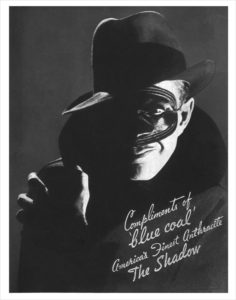
The radio version of The Shadow, as we mostly remember him today, was the mysterious character who had the hypnotic power to cloud men’s minds so that they could not see him. He was the invisible crime fighter who brought terror to the guilty and justice to the innocent. We can listen to his original radio adventures in this modern world thanks to recordings that were made at the time of the broadcasts… recordings which have survived to this day. Yes, over 200 of those recordings can be heard and enjoyed by fans of the old radio series.
If you are one of those people who have heard the voice of The Shadow, you may have wondered who was actually speaking. Who was the actor standing at that Mutual studio mike, who made you believe that The Shadow was real? That is the subject of this week’s blog entry here on That’s Pulp!
The first actor who portrayed Lamont Cranston, wealthy young man-about-town, and his alterego The Shadow, the unseen battler against evil, was Orson Welles in 1937. Before that, however, a different version of The Shadow had appeared on the air.
Beginning in 1930, Detective Story Magazine was broadcast over the Columbia Broadcasting System, and the host of the weekly mystery tales was a creepy-voiced character who called himself The Shadow. During those early years, The Shadow was the host of the show, much as The Whistler was the host of his own 1940’s CBS radio show.
In the beginning
James LaCurto was the first radio actor to voice the part of The Shadow. LaCurto left the series after about three months for a return to Broadway.
The next to voice The Shadow was veteran radio actor Frank Readick Jr. Readick came from a family of actors, and had been on the stage since childhood. As was often the case with Broadway actors, he also took roles in radio dramas to help supplement his income. He was soon a character actor in great demand at CBS, and he was called upon to take over the role of The Shadow when LaCurto abruptly left.
It was Readick’s voice that became recognizable as The Shadow. He truly made the role his own with his creepy, harsh whisper. When he spoke the opening and closing lines and gave out with that sibilant laugh, radio listeners everywhere felt a shiver at the uncanny sound. He remained in the role until 1935, at which time The Shadow radio program left the air for two years.
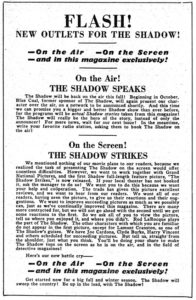
Both LaCurto and Readick played The Shadow as a mysterious voice who introduced the evenings mystery play, and returned with spooky comments between the acts. The stories told on those early broadcasts were not about The Shadow and his own adventures. No, The Shadow was not yet an unseen crimefighter. He was just a mysterious voice who set the stage for the radio play being presented.
It wasn’t until 1937 before The Shadow became a character whose adventures radio listeners could enjoy, even though in the pulp magazines, The Shadow had been confronting the powers of evil since 1931. In the Sept. 15, 1937, issue of The Shadow Magazine, a full-page ad trumpeted The Shadow’s return to the airwaves, but this time “actual Shadow stories!” And to make it perfectly clear they explained, “The Shadow will really be the hero of the story, instead of only the announcer!”
Orson Welles
A young 22-year-old Orson Welles stepped into the role of The Shadow in September 1937. Orson Welles was the first radio actor to portray The Shadow character that remains so well-known today. He was the first to play the part of the mysterious battler of crime who had the hypnotic power to cloud men’s minds.
Orson Welles was born in 1915 and by the age of 15 he had performed and staged his first theatrical productions. When he reached 20 he had already acted on Broadway and produced works of critical acclaim. By 1935 he began acting on the radio, using his earnings to supplement his theater work. He quickly added radio producing and directing to his list of accomplishments.
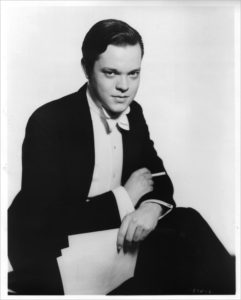
In 1937, Orson Welles was chosen to play The Shadow in a new radio series on the Mutual Broadcasting System. Under the terms of his contract with the sponsor, Blue Coal, he would receive no on-air credit for the role; The Shadow was intended to be a mystery man, unknown to all. His pay was reported to be $185 per week, a princely sum in 1937.
It was a hectic and busy year for Orson Welles. He was working on Broadway and was performing in a variety of radio broadcasts, though usually without credit. Because of his tight schedule, he found a clever way to quickly get from studio to studio. He rented an ambulance. He discovered that there was no law in New York that required the person riding in an ambulance to actually be sick. So he began hiring ambulances to speed him through busy New York traffic with their sirens screaming. In that way, he could get from theater to studio, or from one studio to another, without having to deal with the crowded Manhattan streets.
He also had an arrangement with Blue Coal that he did not need to attend rehearsals. Subordinates would read his lines during the rehearsals and make notes in the margins of the scripts. Welles would show up at the last minute and perform cold. As he explained, “Not rehearsing — which was part of my deal with Blue Coal, the sponsor — made it much more interesting. When I was thrown down the well into some fiendish snake pit, I never knew how I’d get out.”
Frank Readick’s voice returns
The now-famous opening lines of The Shadow radio show — “Who knows what evil…” — were not spoken by Orson Welles. Recordings of Frank Readick’s voice were used. Readick had voiced The Shadow the previous four seasons, when the mystery man was just the narrator, not an actual character in the story.
The reason for the voice substitution was two-fold. First was consistency. The producer of the broadcasts wanted radio listeners to hear the same menacing tones that had become so strongly identified with The Shadow over the previous years, especially during the signature opening and closing lines of the half-hour broadcast. Try as he might, Orson Welles could never quite master the strange sibilant laugh of The Shadow, hence recordings of Frank Readick’s voice were used.
The second reason was insurance. Orson Welles was notorious for his tardiness. He would often rush into the radio studio only moments before they went on the air. Producers feared he might someday arrive too late to speak the opening words. So using a recording of Frank Readick’s voice not only allowed for accidental lateness, but also provided the audio familiarity producers wanted for their radio audiences.
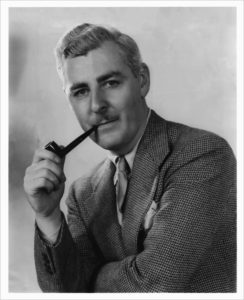
Welles completed the 1937-38 series of The Shadow in March 1938 and immediately began recording a summer series of The Shadow under the sponsorship of Goodrich Tires. Since the summer series was recorded in advance and sent out in syndication to radio stations, Orson Welles’ voice continued to be the voice of The Shadow until mid-September 1938. But he had actually finished recording his performances months earlier. The following week, the 1938-39 season of The Shadow began, and William Johnstone replaced Welles in the role of The Shadow.
A month later, Welles gained instant notoriety with his infamous radio broadcast of The War of the Worlds. A popular myth relates that Welles was forced from his anonymous role of The Shadow after his voice became too famous on that Halloween broadcast of The War of the Worlds. The truth, however, is that he had completed his portrayal of The Shadow some months earlier, when he recorded his last Shadow radio play, “Professor X.”
Welles moved on to Hollywood and even greater fame with his classic 1941 motion picture Citizen Kane. His involvement in movies continued until his death in 1985. At one point in the late ’40s, Welles was said to be interested in adapting the radio series of The Shadow to the silver screen. It was his intent to star in the film, in addition to directing and producing. Unfortunately, the project was abandoned due to lack of investors. It’s interesting to speculate on what kind of a film Orson Welles could have created using the character of The Shadow.
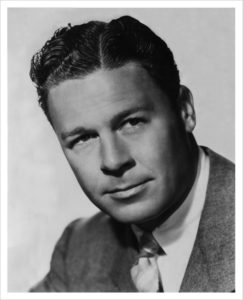
William Johnstone
William Johnstone took the role of The Shadow the next season, and stayed in the part from 1938 to 1943. Johnstone was a former reporter turned busy character actor on radio. He had played small roles on the Shadow broadcasts when Welles was portraying the title character. During his tenure as The Shadow, he portrayed a more stately character. His voice was more mature and he gave the character more of a dramatic weight. After his five seasons with The Shadow, Bill Johnstone moved on to radio acting on a multitude of radio shows. He eventually graduated to television. His longest running role was that of TV’s Judge Lowell on As the World Turns.
Beginning with the 1943 season, Bret Morrison began voicing The Shadow. Morrison was a star on Broadway before he took to radio. Like many Broadway actors, he soon entered the radio field. He kept busy in many radio roles, including The First Nighter Program. His portrayal of The Shadow was younger than that of his predecessor, Bill Johnstone. Johnstone’s voice was lower and carried more authority. Morrison’s voice was more suitable for the “wealthy, young man-about-town” that was Lamont Cranston. After that one season he left… but he would return.
John Archer and Steve Cortleigh
For the 1944 season, John Archer was the voice of The Shadow. Archer was not only a radio actor, but a film and stage actor as well. His first of over a hundred film roles was in 1938. While most leading-man types were serving during World War II, Archer was ineligible for service because of ulcers. That made him a very sought-after actor both on the radio, on Broadway and in the movies. He stayed in the role of The Shadow for that one season and then returned to the stage and Hollywood.
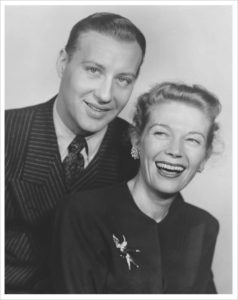
The following 1945 season, a 32-year-old actor named Steve Cortleigh filled in for the first few weeks. He played the part from Sept. 9 until Oct. 28 when Bret Morrison returned to the role. Cortleigh went on to work in early television beginning in 1945 through 1964, three years before his death in 1967.
Bret Morrison returned to the part of The Shadow on Nov. 4, 1945. He would be the last and longest voice of the radio Shadow. He remained in the role for nine more years until the radio series left the air at the end of 1954. At that point, the days of radio drama were waning and Morrison moved to television and acted on various shows including a long run on The Edge of Night.
But it wasn’t quite over for The Shadow. In 1964, Bret Morrison and Grace Mathews went into the recording studio and did two new Shadow adventures, “The Air Freight Fracas” and “The Computer Calculates, But The Shadow Knows.” These were not intended for radio, but rather for LP record. Also on the recordings were Santos Ortega, Ken Roberts, Mandel Kramer, Bob Dryden, and Lawson Zerbe, all veteran radio actors. Four years later in February 1968 these two shorter Shadow episodes were finally released under the MGM label Leo the Lion and given the title “The Official Adventures of The Shadow.”
Probably the best remembered voice of The Shadow is Bret Morrison. After all, he did play the part for the longest, and many recordings of his Shadow episodes still exist. The most famous voice belongs definitely to Orson Welles. But my personal favorite was Bill Johnstone, whose more mature voice carried the knell of doom to those who would mock the law.
And for those of you who would like more details regarding the radio version of The Shadow, you couldn’t do better than purchase a copy of the Martin Grams Jr. book The Shadow: The History and Mystery of the Radio Program, 1930-1954, published by OTR Publishing, 2010. It’s an amazing compendium of everything related to the radio series.


In his short story “The Man Who Collected The Shadow”, Bill Pronzini (who made his “Nameless” Detective a pulp collector) relates the title character’s devotion to the Man in Black that eventually grants him the Shadow’s power of invisibility. The character, Theodore Conway, also collects the radio shows as well as the pulps, and his voice, when he acquires the Shadow’s powers, is described as “Wellesian”. What a great radio show the story would make!
I haven’t read this story. Looks like I’ll be adding another to my “to be read” list! Thanks for the heads-up, Terry!